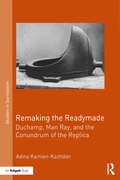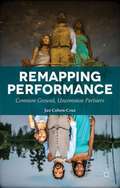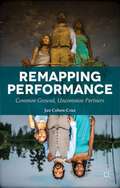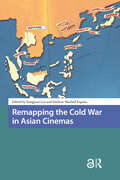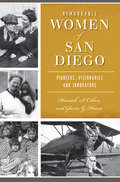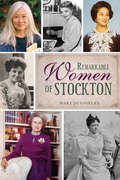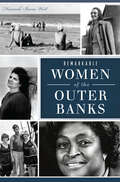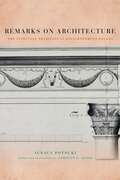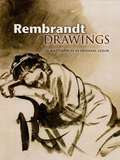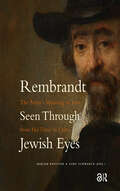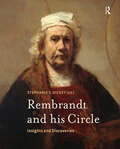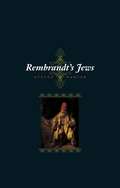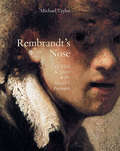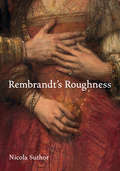- Table View
- List View
Remaking Post-Industrial Cities: Lessons from North America and Europe
by Donald K. CarterRemaking Post-Industrial Cities: Lessons from North America and Europe examines the transformation of post-industrial cities after the precipitous collapse of big industry in the 1980s on both sides of the Atlantic, presenting a holistic approach to restoring post-industrial cities. Developed from the influential 2013 Remaking Cities Congress, conference chair Donald K. Carter brings together ten in-depth case studies of cities across North America and Europe, documenting their recovery from 1985 to 2015. Each chapter discusses the history of the city, its transformation, and prospects for the future. The cases cross-cut these themes with issues crucial to the resilience of post-industrial cities including sustainability; doing more with less; public engagement; and equity (social, economic and environmental), the most important issue cities face today and for the foreseeable future. This book provides essential "lessons learned" from the mistakes and successes of these cities, and is an invaluable resource for practitioners and students of planning, urban design, urban redevelopment, economic development and public and social policy.
Remaking Reality: U.S. Documentary Culture after 1945
by Sara Blair, Joseph B. Entin, and Franny NudelmanAfter World War II, U.S. documentarians engaged in a rigorous rethinking of established documentary practices and histories. Responding to the tumultuous transformations of the postwar era--the atomic age, the civil rights movement, the Vietnam War, the emergence of the environmental movement, immigration and refugee crises, student activism, the globalization of labor, and the financial collapse of 2008--documentary makers increasingly reconceived reality as the site of social conflict and saw their work as instrumental to struggles for justice. Examining a wide range of forms and media, including sound recording, narrative journalism, drawing, photography, film, and video, this book is a daring interdisciplinary study of documentary culture and practice from 1945 to the present. Essays by leading scholars across disciplines collectively explore the activist impulse of documentarians who not only record reality but also challenge their audiences to take part in reality's remaking.In addition to the editors, the volume's contributors include Michael Mark Cohen, Grace Elizabeth Hale, Matthew Frye Jacobson, Jonathan Kahana, Leigh Raiford, Rebecca M. Schreiber, Noah Tsika, Laura Wexler, and Daniel Worden.
Remaking the Readymade: Duchamp, Man Ray, and the Conundrum of the Replica (Studies in Surrealism)
by Adina Kamien-KazhdanReplication and originality are central concepts in the artistic oeuvres of Marcel Duchamp and Man Ray. Remaking the Readymade reveals the underlying and previously unexplored processes and rationales for the collaboration between Duchamp, Man Ray, and Arturo Schwarz on the replication of readymades and objects. The 1964 editioned replicas of the readymades sent shock waves through the art world. Even though the replicas undermined ideas of authorship and problematized the notion of identity and the artist, they paradoxically shared in the aura of the originals, becoming stand-ins for the readymades. Scholar-poet-dealer Arturo Schwarz played a crucial role, opening the door to joint or alternate authorship—an outstanding relationship between artist and dealer. By unearthing previously unpublished correspondence and documentary materials and combining this material with newly conducted exclusive interviews with key participants, Remaking the Readymade details heretofore unrevealed aspects of the technical processes involved in the (re)creation of iconic, long-lost Dada objects. Launched on the heels of the centenary of Duchamp’s Fountain, this new analysis intensifies and complicates our understanding of Duchamp and Man Ray’ initial conceptions, and raises questions about replication and authorship that will stimulate significant debate about the legacy of the artists, the continuing significance of their works, and the meaning of terms such as creativity, originality, and value in the formation of art.
Remaking the San Francisco-Oakland Bay Bridge: A Case of Shadowboxing with Nature (Planning, History and Environment Series)
by Karen Trapenberg FrickWinner of TransportiCA’s September Book Club Award 2018 On 17 October 1989 one the largest earthquakes to occur in California since the San Francisco earthquake of April 1906 struck Northern California. Damage was extensive, none more so than the partial collapse of the San Francisco–Oakland Bay Bridge’s eastern span, a vital link used by hundreds of thousands of Californians every day. The bridge was closed for a month for repairs and then reopened to traffic. But what ensued over the next 25 years is the extraordinary story that Karen Trapenberg Frick tells here. It is a cautionary tale to which any governing authority embarking on a megaproject should pay heed. She describes the process by which the bridge was eventually replaced as an exercise in shadowboxing which pitted the combined talents and shortcomings, partnerships and jealousies, ingenuity and obtuseness, generosity and parsimony of the State’s and the region’s leading elected officials, engineers, architects and other members of the governing elites against a collectively imagined future catastrophe of unknown proportions. In so doing she highlights three key questions: If safety was the reason to replace the bridge, why did it take almost 25 years to do so? How did an original estimate of $250 million in 1995 soar to $6.5 billion by 2014? And why was such a complex design chosen? Her final chapter – part epilogue, part reflection – provides recommendations to improve megaproject delivery and design.
Remapping Performance: Common Ground, Uncommon Partners
by Jan Cohen-CruzCompleting a trilogy of works by Jan Cohen-Cruz, Remapping Performance focuses on the work of artists and experts who collaborate across fields to address social issues. The book explores work of a range of artists who employ artistic training, methodologies and mind-sets in their work with experts from other sectors such as medicine and healthcare and from other disciplines, to draw an expanded map of performance platforms including university/ community partnerships, neighbourhood-bases, and cultural diplomacy. Case studies include ArtSpot Productions/Mondo Bizarro's Cry You One about climate change in southern Louisiana, incorporating theatrics and organizing; Michael Rohd/Sojourn Theatre's social and civic practices; Anne Basting's University of Wisconsin-Milwaukee-based integration of performance and creative aging; and the collaborative cultural diplomacy experiment, smARTpower. Short companion pieces add expertise from Helen Nicholson, Todd London, Julie Thompson Klein, Nancy Cantor, Maria Rosario Jackson, and Penny Von Eschen. Jan Cohen-Cruz ends with suggestions for fully integrating performance in cross-sector initiatives. This latest book by a leading figure in engaged/ applied theatre and performance builds on its predecessors by offering a future-oriented perspective, a vision of art and performance interacting with a range of social sectors and with an emphasis on HE in such partnerships, and will be a 'must-read' for all students and scholars working in this field.
Remapping Performance: Common Ground, Uncommon Partners
by Jan Cohen-CruzCompleting a trilogy of works by Jan Cohen-Cruz, Remapping Performance focuses on the work of artists and experts who collaborate across fields to address social issues. The book explores work of a range of artists who employ artistic training, methodologies and mind-sets in their work with experts from other sectors such as medicine and healthcare and from other disciplines, to draw an expanded map of performance platforms including university/ community partnerships, neighbourhood-bases, and cultural diplomacy. Case studies include ArtSpot Productions/Mondo Bizarro's Cry You One about climate change in southern Louisiana, incorporating theatrics and organizing; Michael Rohd/Sojourn Theatre's social and civic practices; Anne Basting's University of Wisconsin-Milwaukee-based integration of performance and creative aging; and the collaborative cultural diplomacy experiment, smARTpower. Short companion pieces add expertise from Helen Nicholson, Todd London, Julie Thompson Klein, Nancy Cantor, Maria Rosario Jackson, and Penny Von Eschen. Jan Cohen-Cruz ends with suggestions for fully integrating performance in cross-sector initiatives. This latest book by a leading figure in engaged/ applied theatre and performance builds on its predecessors by offering a future-oriented perspective, a vision of art and performance interacting with a range of social sectors and with an emphasis on HE in such partnerships, and will be a 'must-read' for all students and scholars working in this field.
Remapping the Cold War in Asian Cinemas (Critical Asian Cinemas)
by Sangjoon Lee Darlene Machell EspeǔaThis book is about cinema and the cultural Cold War in Asia, set against the larger history of the cultural, political, and institutional linkages between the US, Europe, and Asia at the height of the Cold War. From the popularity of CIA-sponsored espionage films in Hong Kong and South Korea to the enduring Cold War rhetoric of brotherly relations in contemporary Sino-Indian co-production, cinema has always been a focal point of the cultural Cold War in Asia. Historically, both the United States and the Soviet Union viewed cinema as a powerful weapon in the battle to win hearts and minds—not just in Europe, but also in Asia. The Cold War in Asia was, properly speaking, a hot war, with proxy military confrontations between the United States, on one side, and the Soviet Union and China on the other. Amid this political and military turbulence, cataclysmic shifts occurred in the culture and history of Asian cinemas as well as in the latitude of US cultural diplomacy in Asia. The collection of essays in this volume sheds light on the often-forgotten history of the cultural Cold War in Asia. Taken together, the volume’s fifteen chapters examine film cultures and industries in Asia to showcase the magnitude and depth of the Cold War’s impact on Asian cinemas, societies, and politics. By shifting the lens to Asia, the contributors to this volume re-examine the dominant narratives about the global Cold War and highlight the complex and unique ways in which Asian societies negotiated, contested, and adapted to the politics and cultural manifestations of the Cold War.
Remarkable Birds
by Mark AveryEverything you didn't know about the avian world: a fascinating compendium showcasing the extraordinary wonders of birds, illuminated with exquisite ornithological illustrations, prints, and drawings Humans share the Earth with more than 10,000 species of birds and have always been enchanted by them. Birds can be a sign of the changing seasons, a symbol of freedom, or simply a breathtaking vision of beauty. Remarkable Birds approaches these fascinating creatures thematically across eight sections covering all aspects of humans' relationship with birds. "Songbirds" celebrates the greatest bird virtuosi, such as the nightingale, while "Birds of Prey" includes majestic hunters such as the harpy eagle. "Feathered Travelers" describes astounding journeys made by birds including tiny hummingbirds that migrate huge distances. "The Love Life of Birds" illuminates the most brilliant displays upon which different species rely to find a mate--notably the extravagant plumage and dances of birds of paradise. "Avian Cities" explores the spectacular, large colonies of species such as the flamingo, while "Useful to Us" examines the diverse ways we find birds valuable, such as the turkey or the canary. "Threatened & Extinct" describes some species that have been lost forever, and others on the brink. Birds have also had great mystical significance and "Revered & Adored" considers such species as the sacred ibis, believed by the ancient Egyptians to represent the god Thoth.
Remarkable Women of San Diego: Pioneers, Visionaries and Innovators (American Heritage)
by Gloria G. Harris Hannah S. CohenSan Diego enjoys a diverse legacy of formidable female leaders. Ellen Browning Scripps financed and established the groundbreaking Scripps Oceanography Institute. In 1927, Belle Benchley became the nation's first female zoo director and for nearly thirty years pioneered new forms of exhibition and developed the world-class San Diego Zoo. Guatemalan activist and advocate Luisa Moreno established the United Fish Cannery Workers Union to protect the rights of workers during World War II. Ruth Alexander set new altitude records for light planes at the peak of the city's aviation boom. Bertha Pendleton became the first female and first African American San Diego school superintendent in 1993. Authors Hannah Cohen and Gloria Harris document these and many more stories of extraordinary local women.
Remarkable Women of Sanibel & Captiva (American Heritage)
by Jeri MaggIn the history of Sanibel and Captiva, countless women bucked the system to make their marks. In the early 1950s and '60s, Sarita Van Vlick and Zee Butler led the fight to preserve the island from unbridled growth and destruction. Helene Gralnick, in the early '80s, opened a small shop that became the foundation for Chico's Inc. And it was city manager Judy Zimomra who put into practice policies that helped Sanibel flourish after the devastation of Hurricane Charley. Author and local historian Jeri Magg compiles the stories and celebrates the achievements of the remarkable women who forever shaped Sanibel and Captiva Islands.
Remarkable Women of Stockton (American Heritage)
by Mary Jo GohlkeWomen played prominent roles during Stockton's growth from gold rush tent city to California leader in transportation, agriculture and manufacturing. Heiresses reigned in the city's nineteenth-century mansions. In the twentieth century, women fought for suffrage and helped start local colleges, run steamship lines, build food empires and break the school district's color barrier. Writers like Sylvia Sun Minnick and Maxine Hong Kingston chronicled the town. Dolores Huerta co-founded the United Farm Workers. Harriet Chalmers Adams caught the travel bug on walks with her father, and Dawn Mabalon rescued the history of the Filipino population. Join Mary Jo Gohlke, news writer turned librarian, as she eloquently captures the stories of twenty-two triumphant and successful women who led a little river city into state prominence.
Remarkable Women of the Outer Banks (American Heritage)
by Hannah Bunn WestThe Outer Banks of North Carolina attract those with a conviction to dream and do. Explorers, pirates, lifesavers and the world's first pilots decorate the halls of local history.Some of the Outer Banks' greatest accomplishments are due to daring women who pushed the odds. Eleanor Dare created a new life amidst a doomed colonial expedition, Chrissy Bowser found her freedom as the Civil War rocked Roanoke Island, and Irene Tate watched the Wright brothers assemble their glider in her front yard then went on to become a record-setting pilot herself. The women in this book fought for their homes. They stepped outside the traditional roles of their day and age, seeking to preserve its history and heritage. They saved sand dunes and moved lighthouses. Local author Hannah West tells the stories of these remarkable women.
Remarks on Architecture: The Vitruvian Tradition in Enlightenment Poland (G - Reference, Information and Interdisciplinary Subjects)
by Ignacy Potocki Carolyn C. GuileAt the end of the eighteenth century, the authors of Poland’s 3 May 1791 Constitution became the heirs to a defunct state whose territory had been partitioned by Russia, Prussia, and Austria. At this moment of intensive national postmortem, Ignacy Potocki, an eminent statesman and co-author of the Constitution, wrote the treatise Remarks on Architecture.One of the best-preserved examples of early modern Polish architectural thought, Potocki’s work announces itself as a project of national introspection, with architecture playing a direct role in the betterment of the nation. Addressed to the contemporary Polish nobility, the book argues that architecture is a vessel for cultural values and that it plays an important part in the formation and critique of broader national traditions. Throughout, Potocki conveys the lessons of a Vitruvian canon that shaped Continental classical architectural theory and practice throughout the early modern period. Expertly translated by Carolyn Guile and featuring an introduction that explores Polish Enlightenment architectural writing as an example of cultural exchange, inheritance, and transformation, this edition of Potocki’s treatise broadens our understanding of European architectural history during the early modern period.
Rembrandt (World of Art)
by Christopher WhiteThis intelligently revised volume on the life and work of Rembrandt offers detailed insight into the artist from an authority on the subject. Rembrandt is among the few old masters to retain universal appeal among art lovers today. His striking self-portraits and scenes are on view at museums around the world—yet he remains an elusive, enigmatic figure. In Rembrandt, distinguished art historian Christopher White carefully considers Rembrandt’s history to build a sensitive and thorough account of the artist’s life and work. White describes the radiant happiness of Rembrandt’s marriage, tragically cut short by the death of his wife, and discusses the catastrophe of his bankruptcy. Digging deeper, White also explores the psychological factors that may have awakened Rembrandt’s sudden interest in landscape and examines the artist’s final decade, when he retreated into the private world of his imagination. This comprehensive introduction is revised and updated to include recent scholarship and features an expanded bibliography. In this stunning new edition, Rembrandt’s artworks are now faithfully reproduced in color throughout.
Rembrandt Drawings: 116 Masterpieces in Original Color
by RembrandtWith an extraordinary blend of the commonplace and the sophisticated, Rembrandt captured the essential humanity of his subjects. From his intimate observations of everyday life to his richly envisioned biblical allegories, the Dutch master created moving, inspiring images that have captivated viewers across four centuries. This original collection offers an unusual perspective on the artist, consisting exclusively of his drawings--all in their original colors, and most of them in their original sizes.These acclaimed drawings date from the 1620s to the 1660s, spanning Rembrandt's prolific career and documenting his changes in style and focus. Superb examples from every genre of the artist's work include landscape drawings, figure studies, scenes from the Old and New Testaments, animal sketches, and several portraits, including a few of the self-images for which he is famed.Beautifully produced in a generous format on high-quality paper, this deluxe edition offers a rare variety of 116 works from more than twenty major European and American museums. Informative captions accompany each illustration.
Rembrandt Is in the Wind: Learning to Love Art through the Eyes of Faith
by Russ RamseyDid you know Vincent van Gogh sold only one painting during his lifetime and that during the last three months of his life he completed an average of one painting every day?Did you know that Michelangelo's David is covered in a dusting of human skin?Did you know Caravaggio murdered several people while he was painting some of the most glorious paintings of biblical scenes the world has ever known?Rembrandt Is in the Wind by Russ Ramsey is an invitation to discover some of the world's most celebrated artists and works, while presenting the gospel of Christ in a way that speaks to the struggles and longings common to the human experience.The book is part art history, part biblical study, part philosophy, and part analysis of the human experience; but it's all story. The lives of the artists in this book illustrate the struggle of living in this world and point to the beauty of the redemption available to us in Christ. Each story is different. Some conclude with resounding triumph while others end in struggle. But all of them raise important questions about humanity's hunger and capacity for glory, and all of them teach us to love and see beauty.
Rembrandt Seen Through Jewish Eyes: The Artist’s Meaning to Jews from His Time to Ours
by Gary Schwartz Mirjam KnotterThe earliest painting by Rembrandt whose owner is documented depicts the prophet Balaam, on his way to blessing Israel. The man who bought it was a Sephardi Jew in the service of Cardinal Richelieu of France. The first known buyer of an etching plate by Rembrandt, depicting Abraham Dismissing Hagar and Ishmael, was a Sephardi Jew of Amsterdam. Seen through their eyes, Rembrandt was the creator of images with a special meaning to Jews. They have been followed through the centuries by Jewish collectors, Jewish art historians, Jewish artists who saw their own deepest concerns modelled in his art and life, and even prominent rabbis, one of whom said that Rembrandt was a Tzadik, a holy man blessed by God. This book is the first study in depth of the potent bond between Rembrandt and Jews, from his time to ours, a bond that has penetrated the image of the artist and the people alike.
Rembrandt and his Circle: Insights and Discoveries (Amsterdam Studies in the Dutch Golden Age)
by Stephanie S. DickeyThis collection brings together art historians, museum professionals, conservators, and conservation scientists whose work involves Rembrandt van Rijn and associated artists such as Gerrit Dou, Jan Lievens, and Ferdinand Bol. The range of subjects considered is wide: from the presentation of convincing evidence that Rembrandt and his contemporary Frans Hals rubbed elbows in the Amsterdam workshop of Hendrick Uylenburgh to critical reassessments of the role of printmaking in Rembrandt's studio, his competition with Lievens as a landscape painter, his reputation as a collector, and much more. Developed from a series of international conferences devoted to charting new directions in Rembrandt research, these essays illuminate the current state of Rembrandt studies and suggest avenues for future inquiry.
Rembrandt and the Female Nude (Amsterdam Studies in the Dutch Golden Age)
by Eric Jan SluijterRembrandt’s extraordinary paintings of female nudes – Andromeda, Susanna, Diana and Her Nymphs, Danaë, Bathsheba – as well as his etchings of nude women, have fascinated many generations of art lovers and art historians, but they have also elicited vehement criticism. They were considered against-the-grain, anti-classical, even ugly and unpleasant. However, Rembrandt chose conventional subjects, keeping close to time-honored pictorial schemes, and was well aware of the high prestige accorded to the depiction of the naked female body. Why, then, do these works deviate so radically from the depictions of nude women by other artists? To answer this question the author examines Rembrandt’s paintings and etchings against the foil of established pictorial traditions in the Netherlands as well as Italy. Exploring Rembrandt’s intense dialogue with the works of predecessors and peers, the author demonstrates that, more than any other artist, it was Rembrandt’s purpose to incite the greatest possible empathy in the viewer. This had far-reaching consequences for the moral and erotic implications of the subjects Rembrandt chose to depict. In this richly illustrated study the author presents an innovative approach to Rembrandt’s views on the art of painting, his attitude towards antiquity and Italian art of the Renaissance, his sustained rivalry with the works of other artists, his handling of the moral and erotic issues inherent in subjects with female nudes, and the nature of Rembrandt’s artistic choices.This title was shortlisted for the Charles Rufus Morey Award of the College Art Association in 2007.
Rembrandt's Jews
by Steven NadlerThere is a popular and romantic myth about Rembrandt and the Jewish people. One of history's greatest artists, we are often told, had a special affinity for Judaism. With so many of Rembrandt's works devoted to stories of the Hebrew Bible, and with his apparent penchant for Jewish themes and the sympathetic portrayal of Jewish faces, it is no wonder that the myth has endured for centuries. Rembrandt's Jews puts this myth to the test as it examines both the legend and the reality of Rembrandt's relationship to Jews and Judaism. In his elegantly written and engrossing tour of Jewish Amsterdam—which begins in 1653 as workers are repairing Rembrandt's Portuguese-Jewish neighbor's house and completely disrupting the artist's life and livelihood—Steven Nadler tells us the stories of the artist's portraits of Jewish sitters, of his mundane and often contentious dealings with his neighbors in the Jewish quarter of Amsterdam, and of the tolerant setting that city provided for Sephardic and Ashkenazic Jews fleeing persecution in other parts of Europe. As Nadler shows, Rembrandt was only one of a number of prominent seventeenth-century Dutch painters and draftsmen who found inspiration in Jewish subjects. Looking at other artists, such as the landscape painter Jacob van Ruisdael and Emmanuel de Witte, a celebrated painter of architectural interiors, Nadler is able to build a deep and complex account of the remarkable relationship between Dutch and Jewish cultures in the period, evidenced in the dispassionate, even ordinary ways in which Jews and their religion are represented—far from the demonization and grotesque caricatures, the iconography of the outsider, so often found in depictions of Jews during the Middle Ages and the Renaissance. Through his close look at paintings, etchings, and drawings; in his discussion of intellectual and social life during the Dutch Golden Age; and even through his own travels in pursuit of his subject, Nadler takes the reader through Jewish Amsterdam then and now—a trip that, under ever-threatening Dutch skies, is full of colorful and eccentric personalities, fiery debates, and magnificent art.
Rembrandt's Jews
by Steven NadlerThere is a popular and romantic myth about Rembrandt and the Jewish people. One of history's greatest artists, we are often told, had a special affinity for Judaism. With so many of Rembrandt's works devoted to stories of the Hebrew Bible, and with his apparent penchant for Jewish themes and the sympathetic portrayal of Jewish faces, it is no wonder that the myth has endured for centuries.Rembrandt's Jews puts this myth to the test as it examines both the legend and the reality of Rembrandt's relationship to Jews and Judaism. In his elegantly written and engrossing tour of Jewish Amsterdam—which begins in 1653 as workers are repairing Rembrandt's Portuguese-Jewish neighbor's house and completely disrupting the artist's life and livelihood—Steven Nadler tells us the stories of the artist's portraits of Jewish sitters, of his mundane and often contentious dealings with his neighbors in the Jewish quarter of Amsterdam, and of the tolerant setting that city provided for Sephardic and Ashkenazic Jews fleeing persecution in other parts of Europe. As Nadler shows, Rembrandt was only one of a number of prominent seventeenth-century Dutch painters and draftsmen who found inspiration in Jewish subjects. Looking at other artists, such as the landscape painter Jacob van Ruisdael and Emmanuel de Witte, a celebrated painter of architectural interiors, Nadler is able to build a deep and complex account of the remarkable relationship between Dutch and Jewish cultures in the period, evidenced in the dispassionate, even ordinary ways in which Jews and their religion are represented—far from the demonization and grotesque caricatures, the iconography of the outsider, so often found in depictions of Jews during the Middle Ages and the Renaissance. Through his close look at paintings, etchings, and drawings; in his discussion of intellectual and social life during the Dutch Golden Age; and even through his own travels in pursuit of his subject, Nadler takes the reader through Jewish Amsterdam then and now—a trip that, under ever-threatening Dutch skies, is full of colorful and eccentric personalities, fiery debates, and magnificent art.
Rembrandt's Nose: Of Flesh and Spirit in the Master's Portraits
by Michael TaylorThe year 2006 marked the 400th anniversary of the birth of one of the greatest portrait painters that ever lived, the Dutch seventeenth-century master, Rembrandt. Although Rembrandt is among the most important artists in western history, and perhaps our greatest draftsman, no one has ever, until now, been able to pinpoint exactly how it was that he so precisely and effortlessly captured the spiritual essence of his subjects. This insightful, sophisticated and yet accessible illustrated reading-format study, written by the preeminent scholar and translator Michael Taylor, will be as enlightening and delightful to Rembrandt scholars as to lay readers. Taylor looks at Rembrandt's self-portraits, his society portraits, historical paintings and biblical scenes, and identifies how it was that the artist rendered his subjects so alive, so full of earthy, flesh-and-blood vitality--which all boils down to his treatment of the nose. Rembrandt's Nose is a gem of a book, an intimate, candid and extremely entertaining engagement with the works of art themselves, interwoven with racy historical snippets that contextualize the artist's breakthroughs and techniques. It includes some 49 reproductions, as well as a complete chronology of Rembrandt's life.
Rembrandt's Religious Prints: The Feddersen Collection at the Snite Museum of Art
by Charles M. RosenbergA stunning catalogue of the seventy religious prints from the 2017 exhibition, featuring detailed background information on each piece.Rembrandt’s stunning religious prints stand as evidence of the Dutch master’s extraordinary skill as a technician and as a testament to his genius as a teller of tales. Here, several virtually unknown etchings, collected by the Feddersen family and now preserved for the ages at the University of Notre Dame, are made widely available in a lavishly illustrated volume. Building on the contributions of earlier Rembrandt scholars, noted art historian Charles M. Rosenberg illuminates each of the seventyreligious prints through detailed background information on the artist’s career as well as the historical, religious, and artistic impulses informing their creation. Readers will enjoy an impression of the earliest work, The Circumcision (1625-26); the famous Hundred Guilder Print; the enigmatic eighth state of Christ Presented to the People; one of a handful of examples of the very rare final posthumous state of The Three Crosses; and an impression and counterproof of The Triumph of Mordecai. From the joyous epiphany of the coming of the Messiah to the anguish of the betrayal of a father (Jacob) by his children, from choirs of angels waiting to receive the Virgin into heaven to the dog who defecates in the road by an ancient inn (The Good Samaritan), Rembrandt’s etchings offer a window into the nature of faith, aspiration, and human experience, ranging from the ecstatically divine to the worldly and mundane. Ultimately, these prints—modest, intimate, fragile objects—are great works of art which, like all masterpieces, reward us with fresh insights and discoveries at each new encounter.“Despite many reliable catalogues of Rembrandt etchings, very few have focused on the religious content of these prints. The outstanding range of the Feddersen Collection offers an excellent occasion for closer examination of Rembrandt’s development—as a printmaker but also as a spiritual devout Christian, especially evident from his thoughtful return to the same subjects across his career. Charles Rosenberg and his team at the Snite Museum deserve our thanks for fresh analysis of Rembrandt’s religious prints, combined with the latest scholarship on the artist and his etchings output. Rembrandt scholars but also all lovers of the artist will want to consult this important catalogue.” —Larry Silver, author (with Shelley Perlove) of Rembrandt’s Faith: Church and Temple in the Dutch Golden Age“Rembrandt’s etchings of religious themes capture the emotional heart of their subjects through a uniquely inventive approach to both technique and content. . . . The seventy prints gathered by Jack and Alfrieda Feddersen span the full range of Rembrandt’s production and offer an outstanding resource for appreciation and research. This catalogue tells the fascinating story of how the collection was formed and brings a fresh analysis to each print. Charles Rosenberg’s extensive catalogue entries will be useful reading for anyone interested in the history of European art and one of its most talented practitioners, Rembrandt van Rijn.” —Stephanie Dickey, Queen’s University
Rembrandt's Roughness
by Nicola SuthorRoughness is the sensual quality most often associated with Rembrandt's idiosyncratic style. It best defines the specific structure of his painterly textures, which subtly capture and engage the imagination of the beholder. Rembrandt's Roughness examines how the artist's unconventional technique pushed the possibilities of painting into startling and unexpected realms.Drawing on the phenomenological insights of Edmund Husserl as well as firsthand accounts by Rembrandt's contemporaries, Nicola Suthor provides invaluable new perspectives on many of the painter's best-known masterpieces, including The Anatomy Lesson of Dr. Deyman, The Return of the Prodigal Son, and Aristotle with a Bust of Homer. She focuses on pictorial phenomena such as the thickness of the paint material, the visibility of the colored priming, and the dramatizing element of chiaroscuro, showing how they constitute Rembrandt's most effective tools for extending the representational limits of painting. Suthor explores how Rembrandt developed a visually precise handling of his artistic medium that forced his viewers to confront the paint itself as a source of meaning, its challenging complexity expressed in the subtlest stroke of his brush.A beautifully illustrated meditation on a painter like no other, Rembrandt's Roughness reflects deeply on the intellectual challenge that Rembrandt's unrivaled artistry posed to the art theory of his time and its eminent role in the history of art today.
Rembrandt, The Jews and the Bible
by Franz LandsbergerThe author, Dr. Franz Landsberger, himself a fugitive from Nazi terror, wrote this book to share with his readers the solace which he found during the years of persecution in the contemplation of a great artist of Germanic ancestry who had lived for many years among Jews, and who had portrayed them with sympathy. Furthermore, since Rembrandt had always been a devoted reader of the Bible, and one of its most original illustrators, Dr. Landsberger devotes around half of his book to a discussion of Rembrandt’s representation of biblical, or more precisely, Old Testament scenes.“These considerations influenced me to prepare the following pages, which do not present the whole of Rembrandt, but merely that phase of his life and work which has bearing upon his relation to the Jews and to their Holy Scriptures. This phase, however, should prove the more deeply satisfying to us, because it lay not upon the periphery of his personality, but at its very core. For this reason I offer the present work to the consideration of those who, like myself, aspire to a deeper understanding of the phenomenon that was Rembrandt.” (From the Author’s Foreword)


